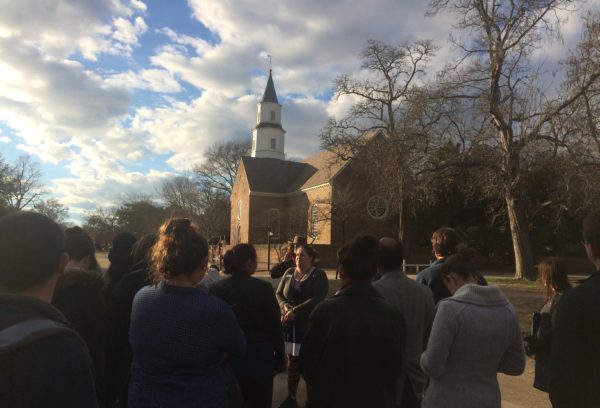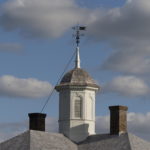
On January 2, the Historic Area shut down for four weeks of extended maintenance, while interpreters and support staff took time to research, train, and catch up after the holidays.
There was an enormous amount of work going on behind the scenes, and while I can’t speak to every area, let me give a little insight into what some of our interpretive staff was up to while the chilly weather set in.
This winter saw interpreters in sessions on the Enlightenment and Women in Trades, walks centered on the city’s archaeology and architecture, tours of museum collections and conservation and archaeology labs, book club discussions, and, of course, some more “academic” training. I even got to fire a flintlock musket (yes, that’s me below!).
This year, every interpreter—trades, groups, first-person, sites, orientation and guest service, Coach & Livestock, theatrical performers…everyone!—went through a four-day intensive study of best practices on interpretive techniques, culminating in each interpreter giving a ten-minute presentation using “theme-based interpretation” in front of their colleagues. Having a common vocabulary and a set of shared skills in our interpretive toolboxes is even more important as we head into our 2017 spring programming, where you’ll see a strategic redeployment of interpreters around key sites. (You may remember reading about some of the changes planned for this year.)
One of my favorite parts of the training was analyzing data on the different types of guests we meet, and what they tend to look for or find important, in order to brainstorm about what recommendations we would make to enhance their experience at Colonial Williamsburg. The ideas ranged from restroom improvements to better integration of technology (within reason). The best part is that some of the suggestions are currently being worked on; others have started to prick up some ears.
Some of our training was geared specifically towards creating awareness and thinking about how we can improve this immersive, sometimes overwhelming experience for guests with exceptionalities. That means finding ways to be more accessible to people who, for example, have physical disabilities, may not learn the same way as others, or have any number of other exceptionalities. Our training department brought in some educators and interpreters from other museums, including one of our own, Sierra. “I wanted to foster awareness of unseen challenges many of our guests face, as well as combat bias and misconceptions that often accompany an unseen disability,” she explained.
From hands-on activities to brainstorming how we could (with an unlimited budget) create tactile, sensory experiences in the Raleigh Tavern (which is opening up for guests again this spring!), the training really opened our eyes to ways to be aware, to know when to offer help, and to keep thinking about how we can reach out to make Colonial Williamsburg a great experience truly open to all. Of course, brainstorming sessions alone can’t fix many of the mobility issues existent in such a vast expanse, or the fact that cannon will be fired daily, but this is a step in the right direction towards inclusivity.
Between the different training sessions, book clubs, updates on buildings and new initiatives, and rehearsals, you’d think that would be about all we could cram into the quieter season. But wait! There’s more!
Ever see those very professional and incredibly knowledgeable Colonial Williamsburg employees in plainclothes with a group of 45 fifth graders slipping into the Palace in between the regularly scheduled tours? Or a small group of adults guests who look like they’re from a conference waiting to go into a trade shop? That’s our School and Groups Department. Approximately 25 interpreters from across the Historic Area are cross-training with them.
These interpreters are trained on state educational content standards (which vary greatly), different methods of teaching, and, of course… some basics about each trade shop, plenty about the lives of the people living and working in Virginia in the 18th century, and how to give tours not just of the “big buildings” like the Palace, but also teach about places like Wetherburn’s Tavern, lead discussions on religion at Bruton Parish Church, and how to tie all of the places, people, and culture of Colonial-era Virginia into something relevant and tangible for whatever group steps in front of them.
During the high seasons for field trips, spring and fall, you’ll see as many as 30 guides are on the streets daily, leading three-hour tours of the city, packing in the Capitol, Palace, and multiple Historic Trades, doing hands-on activities, and tying it all together so that (hopefully) it will spark the interest of students, who will return home not only knowing something different…but wanting to learn more.
If this seems easy, just refer to my “January pause” post from last year, which detailed what Sites Interpreters go through for each individual building they learn, cram it into a much smaller time frame, add a dozen more buildings, teaching methods, timing throughout an entire city built around teacher requests, bathroom breaks, buses running late, and an opportunity to be the main person from Colonial Williamsburg that any of these groups will interact with for more than 5 minutes….and you may have an idea of why we are still in training through the middle of March!
There are so many more opportunities for you—as a teacher, a family reunion, or a business conference—to call and book one of our groups interpreters to lead you on a personally-tailored tour of our fair city. The core team of School and Groups Interpreters also do specialty tours—this spring they will premiere Renegade Tours, beginning March 25 and running every Saturday through the spring season. “It is geared for the adult audience and is a one-hour, fast-paced walking tour that features the wild and bizarre of Williamsburg’s past and present,” described Susan Gilliam, School and Groups Manager.
As you can see, the work is ongoing. With new experiences coming to many of our sites this spring, the Raleigh Tavern opening back up for guests, and group’s interpreters coming out of our eyeballs, the past couple of months were not much of a break for those who work here.
I would like to invite you to join us, come and “play into learning” in the manner of John Locke. Ask us questions, delve deeper, and bring a friend to experience all we’re working to bring you.
Guest Blogger: Whitney Thornberry Austin
Whitney is a Sites Interpreter who has been with the Foundation full time since March of 2015, and performing in evening programs since 2014. She and her husband, Bryan, live in the Historic Area with their rescued pup Derby (a sweet girl who thinks the horses are just big dogs with which to play).
Whitney loves hosting dinner parties, sewing, reading, distressing furniture, science fiction, historical dramas, old movies and anything from the Williamsburg Winery. Her mother used to say she was born in the wrong century—and now she gets the best of both!

Well done! It always a pleasure to read your articles.
Too bad guests won’t be able to experience the art of white oak basketmaking, interpretation of the Gaol, visits to Great Hopes anymore with all the cuts and layoffs going on. “Strategic redeployment” sounds like nothing more than PR spin to hide the fact programming will continue to shrink and shrink and the quality will decline with fewer dedicated and knowledgeable employees both in front of guests and behind the scenes. Hope this treasiure isn’t just turned into another run-of-the-mill resort, but given that’s where it seems resources are being directed, I’m deeply troubled.